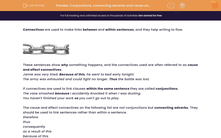Connectives are used to make links between and within sentences, and they help writing to flow.
.jpg)
These sentences show why something happens, and the connectives used are often referred to as cause and effect connectives.
The army was exhausted and could fight no longer. Thus the battle was lost.
Jamie was very tired. Because of this, he went to bed early tonight.

If connectives are used to link clauses within the same sentence, they are called conjunctions.
The vase smashed because I accidentally knocked it when I was dusting.
You haven't finished your work, so you can't go out to play.

The cause and effect connectives on the following list are not conjunctions but connecting adverbs. They should be used to link sentences rather than within a sentence:
therefore
thus
consequently
as a result of this
because of this
thanks to this
Joey ate too much cake at the party. Consequently, he was sick on the way home.
Note that this is two separate sentences. It is not: Joey ate too much cake at the party consequently he was sick on the way home.
Connectives used within a sentence are called conjunctions and link clauses together to create a sentence.
There are seven conjunctions that link two main clauses together: for, and, nor, but, or, yet and so.
These can be easily remembered by taking the first letter of each conjunction to make the word FANBOYS
Other conjunctions link a main clause to one or more subordinate clauses and there are many examples of these.
Here are just a few of them: because, although, while, since, after
Ready to have a go yourself? Let's get started!








